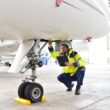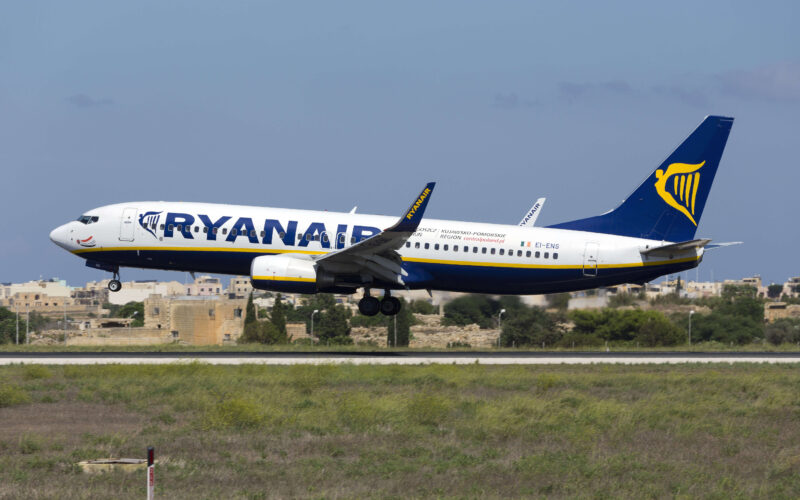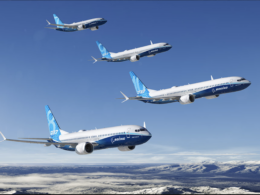Ryanair To Establish Malta Air – A New Airline In Malta
On Sunday, Times of Malta has announced that Ryanair is establishing one more subsidiary airline. This time it’s located in Malta and will be named Malta Air. The new company will follow the same business model as its parent and will offer low-cost flights to and from the island.
While the contract is still not signed, the possibility of it happening is very likely, because the Maltese government aims to reposition Malta from a tourist hot-spot to a transitional destination, comparable to Iceland.
Uptade: Ryanair has officially announced on the 11th of May, that together with the government of Malta, the airline has established a new subsidiary airline called Malta Air.
Of course, the two islands will compete in two very different markets, as Iceland has a long history of dominating the transitional movement of passengers from North America to Europe and vice-versa.
Ryanair’s expanding horizons
The Irish low-cost carrier recently has been on a mission to expand its business ventures by establishing several subsidiary airlines all over Europe and Malta is the latest destination.
Firstly, there was the Ryanair UK subsidiary, which applied for an Air Operator Certificate in the United Kingdom in late 2017. As the uncertainty of Brexit was at an all-time high and various airlines, including easyJet and Wizz Air, the biggest competitors of Ryanair, established subsidiaries in the United Kingdom in order to continue operations smoothly even in the case of a no-deal Brexit. (because easyJet is registered in the United Kingdom, the company established easyJet Austria to operate in Europe)
However, as of June 2019, Ryanair UK currently owns only one aircraft under its registry – a Boeing 737, registered G-RUKA.
Then Ryanair in April of 2018 ventured into new waters (or rather skies) and opened up Ryanair Sun – a charter airline in Poland, with a Polish AOC. While at first, the airline operated charter flights only, Ryanair Sun started to operate scheduled flights. Then, in March of 2019, Ryanair announced that Ryanair Sun is rebranded into Buzz and will start offering more scheduled flights (charter operations will stay). The rebranding process will be completed this autumn. In addition, the airline will receive 8 more Boeing 737’s.

Lastly, there was the Austrian venture, when Ryanair slowly purchased Lauda or as it was previously known, Laudamotion. The purchase was completed in late 2018 and Ryanair incorporated the Austrian airline into their operations. Nevertheless, Lauda still operates under a separate AOC certificate.
Maltese adventure
And now, Ryanair seems to be getting into a new adventure in the little European island of Malta. The Maltese government is also very keen on the deal to go through. The government wants to reposition the island to a transitional destination, as we mentioned above.
The Times of Malta has reported that the new airline called Malta Air will replace Ryanair‘s branding on routes to and from Malta – there are a total of 68 destinations as of 2019. Reportedly, the prices will be in line with Ryanair‘s low-cost options.
Ryanair will also transfer 10 Boeing 737s to Malta Air. Subsequently, the brand-new airline will employ around 350 people, from pilots, cabin crew members to engineers and other maintenance personnel.
However, the deal has raised some questions. Especially when the Malta government is involved. For Ryanair, this deal would be a brilliant opportunity – more destinations, a new base and possible tax breaks for committing in Malta.
For the government of Malta and it‘s flag-carrier, Air Malta? Not so much. Let‘s look into why.
Malta Air and Air Malta
If the reported deal is true, the government of Malta will now own shares in the new low-cost carrier Malta Air.
But Malta has a flag-carrier – Air Malta, operating under a different business model, thus offering much more expensive tickets.
The main shareholder of Air Malta? The government of Malta.
While it points to a very obvious conflict of interest, the new Ryanair subsidiary might create a big problem for Air Malta.
On March 23rd, Air Malta has reported its financial results for 2018. The airline is in a tough financial spot, to say the least.
In 2018, Air Malta reported its first profit for 18 years. Even then, the profit is quite low and according to the report, is only €1.2 million. Nevertheless, the great news is that no matter the hardships throughout the years, the airline has managed to turn around their financial situation around.
Main profitability factors are decreased operational costs and increased passenger numbers. Compared to 2017, Air Malta has carried 168 000 more passengers (1.7 million in 2018, 1.5 million in 2017) due to the airline operating new routes.
But a profitable 2018 doesn’t mean that Air Malta will be successful in the near future.
Air Malta is on a good track – the airline has offered its economy-class passengers to purchase additional items on-board, increasing the ancillary revenue. New routes allow the airline to bring in new passengers, thus increasing the revenue.
However, the biggest issue is fuel prices. Out of 10 aircraft that Air Malta operates, only one of them is an Airbus A320neo, which has a significantly less fuel-hungry engine. The other aircraft, bar another one, are between 12 and 15 years old.

As a result, if fuel prices go up, Air Malta’s financial books will go red again.
Even extreme situations could happen – for example, this winter Southwest Airlines (LUV) suddenly had 40 planes stay put due to maintenance issues and problems with their aircraft mechanic union. On a normal day in Southwest, around 20 aircraft stay put for the engineers to conduct checks or repairs. What if this does happen to Air Malta, as the airline only has 10 aircraft?
Thus, Air Malta is treading on very thin ice.
Meanwhile, Malta Air has many safety nets it can go back to.
Malta Air protected by Ryanair
There is no secret that Malta is a holiday destination.
Reading Malta International Airport‘s statistics for 2018, during the peak holiday season in August, there were 759 646 passengers that have arrived and departed from Malta.
The same year but in January, Malta’s main airport saw 400 000 passengers less – 351 550 travelers have stepped inside the airport to fly from or to Malta.
Now, let’s look at the two different airlines. Air Malta is essentially tied to Malta and is not very flexible in that regard. It cannot suddenly start offering flights from Rome to London for example.
On the other hand, Malta Air is much more flexible. Being a Ryanair subsidiary, Ryanair can just transfer the aircraft to other parts of Europe where traffic has not significantly dropped.
Ryanair group’s (Buzz, Lauda, Ryanair) profits can also cover the decreased profitability of Malta Air during the winter months, even if Ryanair themselves have reported a significantly reduced profit for the financial year of 2018.
As I mentioned above, Air Malta runs aircraft that are quite old. On the contrary, Ryanair’s aircraft are quite young – on average the aircraft is 7.8 years old, according to planespotters.net.

This means that Ryanair’s fuel bill is significantly lower per aircraft.
Since Ryanair will transfer its own aircraft to the new airline Malta Air, its fuel bill will also be significantly lower.
All of the factors come down to one fact – Malta Air will be able to undercut Air Malta’s prices to a point where the legacy carrier won’t be able to compete.
Malta’s aviation market
Matter of the fact is that Malta’s aviation market is not big enough to support both Malta Air and the older Air Malta.
Out of 6.8 million passengers in 2018, Air Malta carried 1.7 of them. While passenger numbers have increased compared to 2017, if Malta Air starts to scale up operations from the island, Air Malta will simply be driven out, as passengers start to prefer the lower ticket prices, rather than the Air Malta’s offer of supreme service in the sky.
And if the deal goes through, it’s only a question of time when Malta Air does start to offer more routes.
In a way, the situation is comparable to the Jet Airways crisis that has unfolded over the past year. The main difference is that Malta’s domestic market is simply not big enough to justify a war over customers, where one airline has a significant advantage – their business model allows offering cheaper ticket prices. In India, as we have reported, legacy airlines simply cannot compete with low-cost carriers in the domestic market due to the significant price difference.
Air Malta could become the new Air India, where the government keeps dumping cash, yet the airline is simply unable to stay profitable, meanwhile, low-cost carriers like Malta Air would strive.
The Times Of Malta article has opened up about a new opportunity for Air Malta to expand into the medium and long-haul market. But is an opportunity even there?
Malta as a transitional destination
Similar to Iceland, the government of Malta wants the airport of Malta and Air Malta to become a huge asset – a connecting hub.
However, Iceland has a significant advantage – it is between two huge markets in the aviation industry, namely Europe and North America.
Nevertheless, the hub-and-spoke model is slowly fading away. Point-to-point model of transferring passengers directly from point A to point B is becoming the new hot topic in the airline business.
Looking geographically, Malta seems like an ideal hub for connections between Europe and Africa, the Middle East and the rest of Asia.
But there are several issues with Malta becoming a transitional destination for passengers.
Business model
Firstly, as I mentioned above, the hub-and-spoke airline model is slowly fading into irrelevancy. Airlines now prefer to deliver direct connections to passengers. The newest aircraft, such as the Airbus A350, Airbus A330neo, Boeing 777X and Boeing 787 allow airlines to offer long-haul flights to destinations that are half a world apart, like the Singapore Airlines (SIA1) (SINGY) record-breaking flight between Singapore and Newark. Singapore Airlines (SIA1) (SINGY) operates that flight with an Airbus A350.
Qantas is looking for aircraft for their Project Sunrise to connect Sydney and London with a direct flight.
Air Malta only has Airbus A320‘s. So, from here on out you have two options – start codesharing, which goes back to the same hub-and-spoke model or invest billions and ship off Air Malta‘s A320s to make way for proper long-haul aircraft. Question is if the government of Malta is investing in a low-cost carrier, will it even have enough cash to invest into Air Malta‘s fleet overhaul? Doubtful.
Location and airport
Secondly, the same geographical location can also be a disadvantage. Around Malta (well, relatively around) there are multiple big airports that overshadow Malta International Airport‘s capabilities of becoming a huge hub for connections.
There is Rome‘s Fiumicino, which handles almost 43 million passengers per year and has 4 runways, meaning it has the capability to handle many more passengers. Then there is the new airport in Istanbul, which plans to have 8 runways by 2027 and be able to handle 200 million passengers.

And these are just two examples, there are quite a few more major airports that are relatively close to Malta. Meanwhile, Malta‘s airport has 2 runways and handles 6 million passengers per year.
Now, if you‘re an airline looking for a hub to connect Europe and a region such as Africa, Asia or the Middle East, would you move to a relatively small airport in Malta or such airports as Rome Fiumicino or Istanbul International Airport?
Not to undermine Malta‘s airport, as it‘s a greatly managed airport, but simply put – it‘s too small to even become a major hub. In contrast, Iceland did not have any major airports around the country to compete.
Passenger numbers
Finally, there are the passenger numbers. Out of the 6.8 million passengers that have traveled through Malta in 2018, 1942 were transitioning passengers.
No, not 1.9 million. Nor 194 thousand. Just 1942.
So, in order to convert Malta into a huge transitioning destination, the government of Malta will have to invest huge heaps of money into both their legacy airline Air Malta and the airport at the island. Not just in aircraft, construction or expansion of the airport. The government has to also include a major sales and marketing pitch to airlines around the world.
But even then, Malta even has barely enough space to expand the airport. Malta is one of the most densely populated countries in the world, ranking at number 5 out of 194 ranked countries.
All in all, the deal would be wonderful for Ryanair – grabbing a firm hold on an airport, getting possible tax exemptions would be only beneficial and would add to the flexibility of the Irish airline.
For the Maltese government? Not so much. Malta Air can potentially drive out Air Malta, the legacy flag-carrier of Malta due to the lack of flexibility, lack of facilities and lack of opportunities to expand its own operations.
This just raises one question: why would the government of Malta even get involved in this kind of ordeal?









